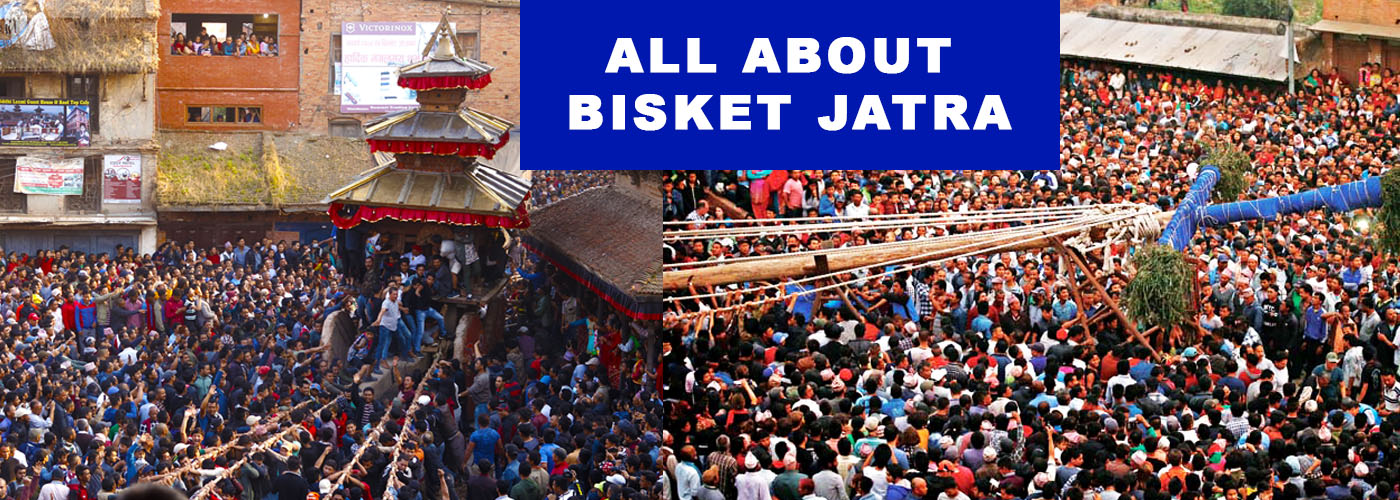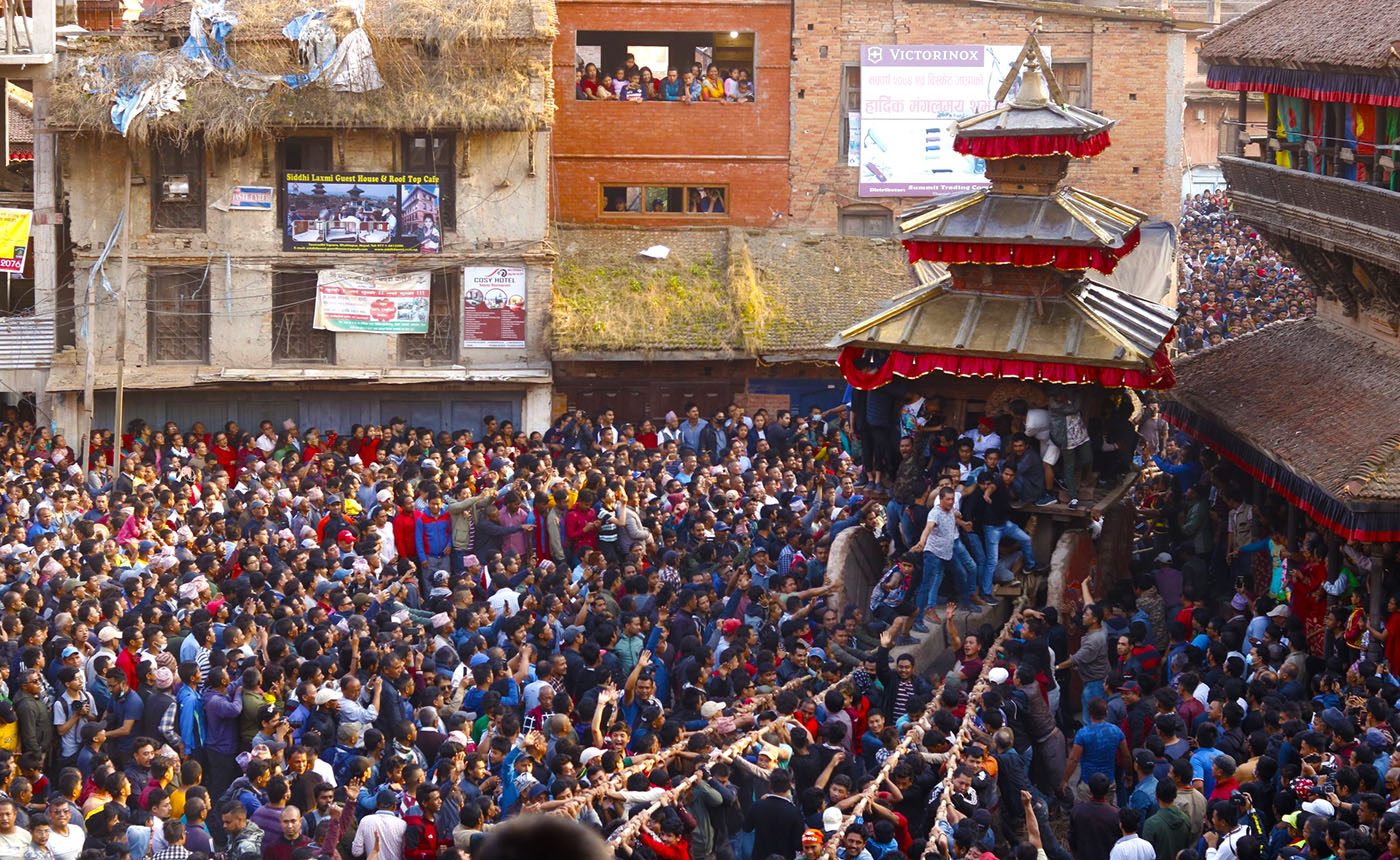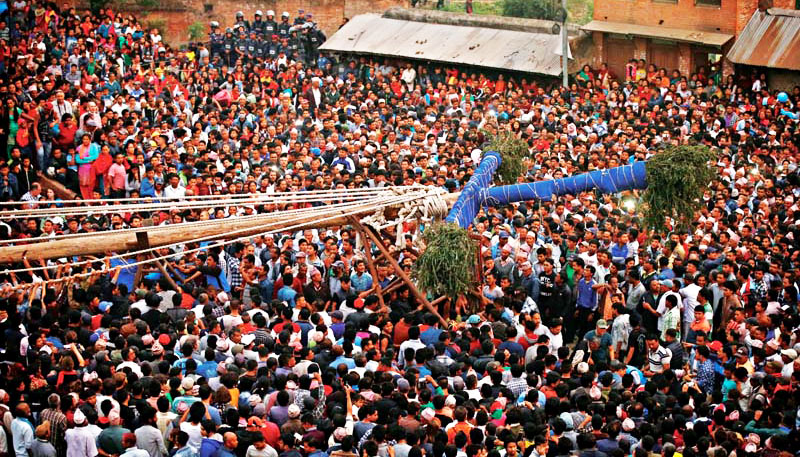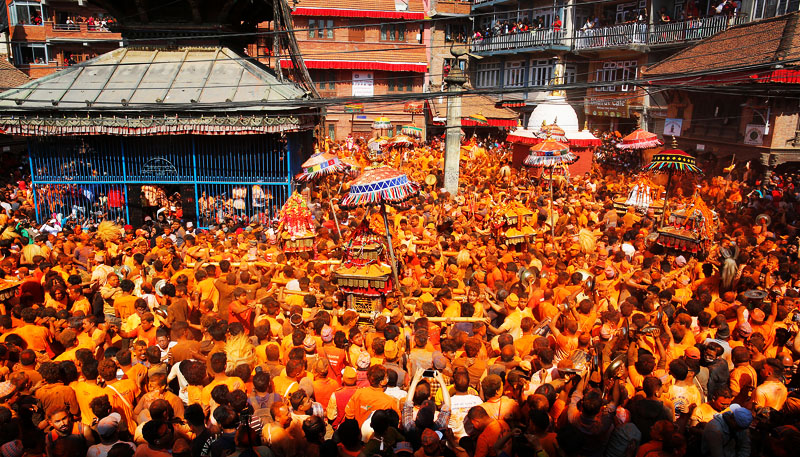
Bisket (Biska) Jatra is a grand festival, celebrated every year in the Bhaktapur district with great joy and enthusiasm. This festival continues for 9 days and 8 nights, from the last week of Chaitra (last month of Bikram Sambat Calendar) to the first week of Baishakh (first month of Bikram Sambat Calendar).
This is the only festival in Nepal that doesn’t follow the lunar-based calendar, which means this festival always falls in April between the 10th and 19th.
The major highlight of this festival is the ritual of pulling the chariot by two opposite parties. One week before the ceremony commences, the chariot (Bhaila Kha) is built in front of the Nyatapole (Five-storied) temple. What happens next is mentioned below.
1st day

Crowds pulling the chariot (Bhaila Kha) in front of Nyatapola Temple in Bhaktapur.
PC: Mikej Tamrakar
On the first day, the priests (Pujaris) from Guthi perform the Bhaila Kha (Bhairav) puja in front of the Nyatapole temple.
During the procession, a Newari musical team plays the Bansuri and Dhime to create a melodious setting. A large group of people (in fact, countless people) show their presence during this ceremony.
After the puja is over, one party from the eastern side (Thane) and the other one from the western side (Kone) pull the chariot towards their direction as in a tug of war. If the former party wins, the chariot is taken to Golmadhi; while in the opposite case, the chariot is taken to Naasamanaa, or Tekhapukhu (occasionally).
People become highly excited during this festival. Seeing the crowds, you will realize how significant this festival is in the heart of Bhaktapurians (especially Newars).
If the time favors, the chariot is taken to Ga: hiti on the very same day.
2nd day
On this day, the Bhaila Kha (Chariot where Bhairav is kept) is moved to Ga: hiti. The Bhairav, inside the chariot, is kept in a safe place by the priests from Guthis.
3rd day
There are no special pujas or ceremonies on the 3rd day.
4th day

This day is the end of Chaitra and is a special one. During the mid-day, a Lingo (25 m long wooden pole) without arms is erected in the Pottery Square of Bhaktapur, while during the evening, another Lingo (with extended arms) is established in the Bhelu Khel.
Soon after the Lingo erection ceremony is over, Tipwa Jatra begins. In this Jatra, Barahi Khat (palanquin) is carried on the arms from Barahi Dya Chhen (in Bansa Gopal) to Barahi Ajima (in Suryabinayak) through a river. This palanquin is circumambulated around the Barahi Ajima and for the night kept there.
On the other hand, the chariot of Bhairav is taken to the Bhairav temple and worshipped there.
5th day
The fifth day is the new year in Nepal according to the Bikram Sambat Calendar. On this day, the lingo with arms, that was erected in Bhelu Khel, is pulled down by a group of people, early in the morning.
Then, the chariot (Bhaila Kha) is brought back to Ga: hiti from the temple of Bhairav. At the same time, another chariot (Nakinju Kha) of Bhadrakali deity (wife of Bhairav) is brought from the Kone region to Ga: hiti.
These two chariots are stroke 3 times softly in Ga: hiti and worshipped by the Pujaris. After that, the Nakinju Kha is separated from the Bhaila Kha.
[If otherwise, the lingo couldn’t be set-up on the 4th day, all the ritual of the fourth day is performed on the fifth day.]
6th day

6th day is another interesting day. Devotees from Madhyapur Thimi practice Sindur Jatra by spreading a red vermillion powder to one another. The reason behind the celebration of Sindur Jatra is to welcome the spring and new year.
On the other hand, there is a tongue-piercing ritual celebrated on this day. One of the volunteers from a Shrestha family pierces his tongue by an iron spike and strolls around the town carrying a bamboo rack on his shoulder. Juju Bhai Shrestha is one of the famous figures for tongue-piercing.
7th day
On the 7th day, the two palanquins (one of Mahalaxmi and the other of Mahakali) of Hindu deities are joined in the Bhola Chhen and a puja ceremony is organized by the priests.
8th day
On this day, Dya Swogan Be Garne (Sagun Ceremony) is celebrated by offering five delicacies – rice wine, meat, fish, boiled egg, and lentil cake – to the Hindu deities as a representation of five tantric elements – fire, earth, water, air, and ether – respectively.
9th day
This is the last day of the Bisket Jatra. Like in the first day, the chariot of Bhairav is pulled by two opposite parties, and at the end of the day, the chariot is brought back to the Nyatapole temple that marks the ending of Bisket Jatra.
It is believed that the Jagat Jyoti Malla (one of the kings of the Malla Dynasty), who had a great fascination with mythical stories, inaugurated this festival, being inspired by one of the popular myths of a cursed princess.
According to the myth, there was a princess, who was cursed that if an unfortunate bride marries her, he would lose his life. As per that, whoever she married was found dead, the next morning. Seeing this, nobody dared to marry her. She thought she was destined to be alone and unhappy.
Suddenly, one day, a young man (from a poor family) mustered some courage to marry the princess despite a lot of refusal from his mother. But then, a stranger lady met that boy and advised a plan that could make him alive.
The boy married the princess and on the first night with the princess, he woke up all night (as per the advice of the Lady) carrying a sharp knife. He was convinced not to sleep. After a while, the princess fell asleep and began snoring calmly.
Everything was going fine for a while and nothing seemed to happen. But then, suddenly, two serpents came out of her nostrils. He was very much shocked and couldn’t believe his eyes. Without any delay, he cut the snakes into pieces and escaped death.
Later on, when other people heard about this story of the boy, they believed that the stranger lady, he had met, was a deity Bhadrakali in disguise. Therefore, they conducted a large procession in reverence to Bhadrakali in the street, which is today’s Bisket Jatra.
Leave Your Comment